- Retour accueil
- Vous êtes ici : Blog The Pyramids of the Cold v2 The Pyramids of the Cold Section 44 • The holy water fonts and the biosand filter
The Pyramids of the Cold Section 44 • The holy water fonts and the biosand filter
Publié par Bruno Coursol dans The Pyramids of the Cold v2 le 31/10/2023 à 09:06

If holy water fonts made from giant clam’s shells are set at the entrance of Christian churches all over the world, this is not because they are cute and convenient: there is a profound but metaphorical reason for that. Churches are the house of God, the house of the Living and the house of the knowledge of the past; and the shells of giant dead clams are only direct references to the extraordinary feeding capabilities of the living animal: giant clams are not only feeding themselves from the filtration of salted water, they are also and more importantly cultivating their own colony of living microorganisms. And this is what the giant clams holy water fonts are all about: they are both about filtration that produces potable water, and the unique colony of microorganisms living inside the clam’s own tissues. In short, they are about the biosand filter.
The Pyramids of the Cold v2 (May-October 2023) • Epilogue Part Five
Section 44 • The Holy Water Fonts and the Biosand Filter
In summary: what we’ve seen in last three Sections was all about the operation of the Grand Gallery (the impactor, the hauling Beetle, the Egyptian pulleys and ropes), and its “reinterpretation” in the Jewish religion; in this last Section we are getting back to the real chore and start of the study: the evaporative cold and the mandatory processes of the water treatment needed to ensure efficient results. We are also leaving Jewish religion to focus on the one religion where water is key: the Christian religion.
We’ll see how Christians have celebrated what was probably seen as the most advanced piece of equipment at the time of pharaohs: the biosand filter. We’ll see the beautiful metaphor which had been chosen to glorify the filter with the very peculiar and specific feeding of giant clams, and the real meaning of the holy water.
Many people see the old past of the Mediterranean region as “picturesque” and the people who lived at the time as simple “indigenous”, or even worse: “black indigenous”. The Old time in this particular region of the world, was nothing like that; or at least the high society was nothing like that; they were just like we are today: both about religion and all about science. The only difference is that at the time, religion itself was all about science as well.
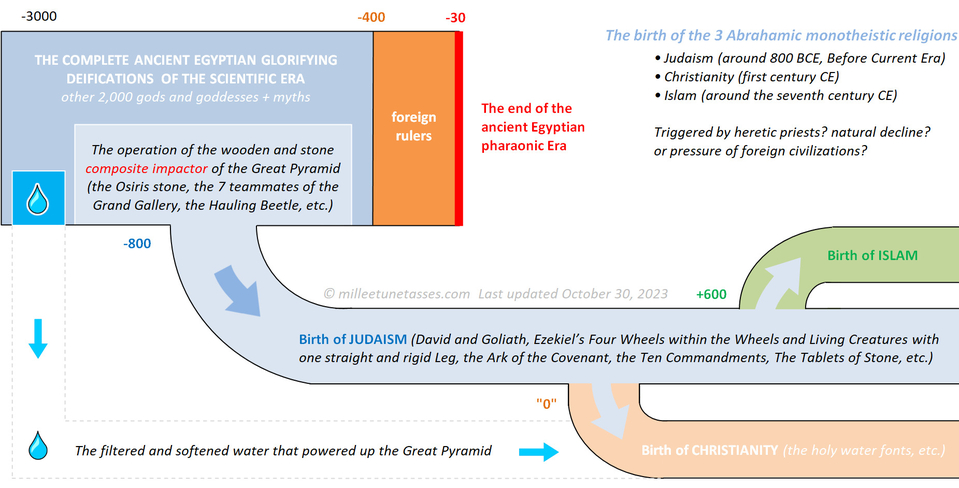
Nobody will tell you that, but it certainly is no accident if the three Abrahamic monotheistic religions (Judaism, Christianity and Islam), all sharing many common prophets and stories, also come from the exact same place where the most important religion of all times appeared, grew and died: these three modern religions are all originating in the ancient Egyptian religion, and they are all fantastic reinterpretations of this ancient original religion which developed over 2,000 gods and goddesses; each and every one of them simply being metaphorical glorifications and celebrations of ancient Science and Technology, both experimental (Isis is about hauling ropes, Ra and Osiris are respectively about the wooden part and the stone part of an impactor, Horus being the combination of these two parts, etc.) and theoretical (like the endless evaporative and condensing cycle of water, with Geb, Shu and Nut in Section 3).
44.01 The Great Renouncement despicably perpetrated by historians since the early 1800s
Maybe more than in any other Section of this study, clearly appears the gigantic gap that separates in one hand the extremely simplistic and naive vision of the ancient world presented to us by historians, and which only originates in the archaic ideology of the early 1800s of the western world towards the ancient Mediterranean cultures, from in the other hand, the so sophisticated truth about our common past.
The “failure” in which historians are indulging themselves from more than 200 years now, only dwell in their common renouncement in deciphering the myriad of metaphors which are spread all over the ancient world’s cultures and religions. In this study, we’ve already seen that most of these metaphors, whether they come from the ancient Egyptian religion, Judaism, Norse, Tibetan or Hindu mythology, they all are directly referring to the operation of the Great Pyramid of Egypt, 4,500 years ago.
It is still unclear to me how many of these reinterpretations were also assumed glorifications of the scientific and technological knowledge of the ancient Egyptians, and how much the people understood these metaphors; and this Section is about what was probably seen at the time as the most advanced technology of all: the biosand filtration which combines standard sand filtration with the culture of a population of chosen and benevolent microorganisms.
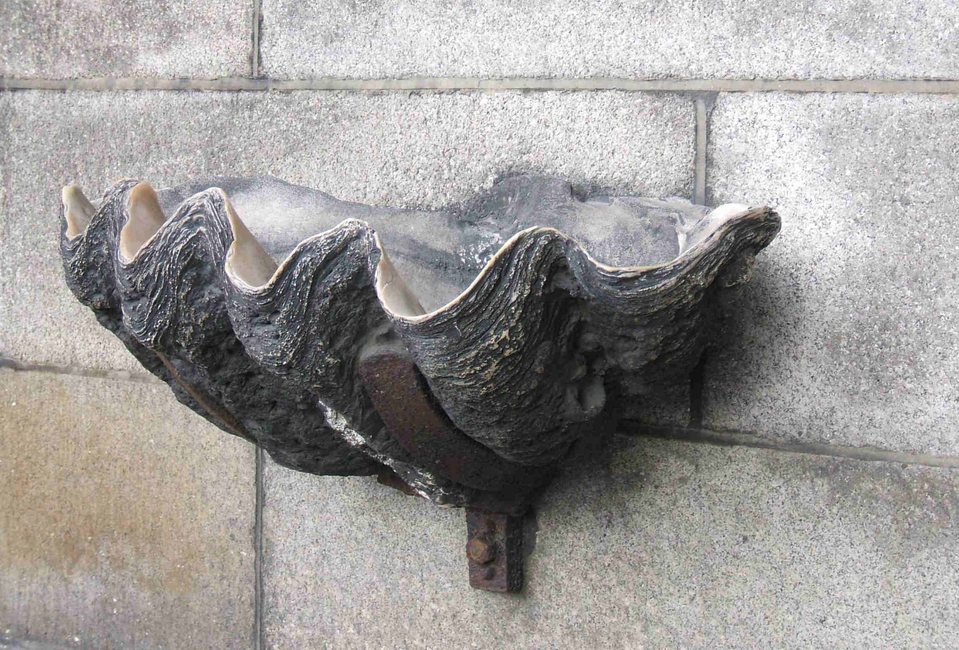
Giant clam holy water font at St. Audeons Catholic Church, Dublin; adapted from a photograph by Stuart. “One of a pair of giant clam (Tridacna gigas) holy water fonts located on either side of the main entrance door. These were donated in 1917 by a brother of one of the priests serving in St Audeons.” https://www.flickr.com/photos/23885771@N03/3998237161
44.02 The lifeless empty shells of the giant clam holy water fonts, versus...
Historians are looking at giant clam holy water fonts, only as the empty shells of dead animals; like they were thinking our ancestors simply went antiquing to find the best holy water fonts for their churches, for no particular reason... But the fact is there is a reason; a reason that no scholar historian would have ever been able to find, simply because that reason is all about biology; the biology of the giant clam and the way these animals are feeding themselves.
In most western countries, holy water is actually salted water: you take some plain water, add a little salt, ask for a priest to pronounce some magical words, and there you have a brand new holy water batch. The question I’m asking is simple: how come nobody ever talks about the fact that you put holy salted water inside the shell of an animal, who spent its entire life filtering salted water all day long, 24 hours a day, to feed itself? Is it too hard to believe that there is a direct connection between holy salted water and the process of filtration itself?
Of course, if you haven’t already understood the real nature of the ancient Egyptian religion, nor the real function of the Great Pyramid or the astonishing influence they both had on the entire ancient World and in particular on the birth of the three Abrahamic religions (Judaism, Christianity and Islam), there is no chance you could have figured out the real meaning of the holy water, nor the real function of the holy water fonts.
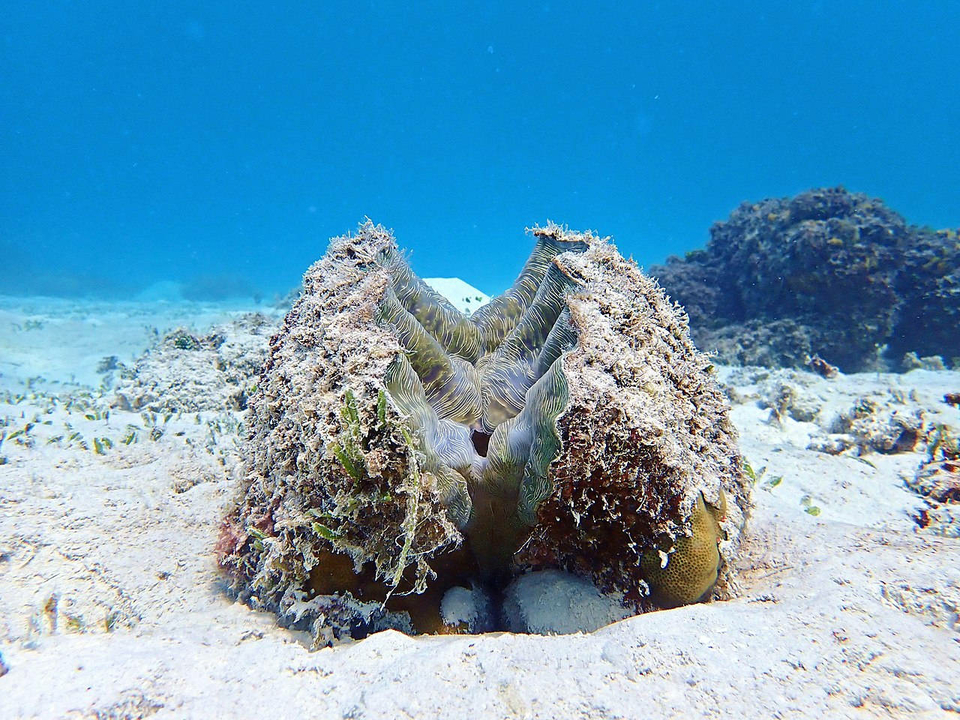
A bear-paw clam (Hippopus hippopus) observed in Vanuatu (Lonnoc, Santo Island), at the same time filtering salted water and taking advantage of its own culture of benevolent microorganisms, by Frédéric Ducarme: https://en.wikipedia.org/wiki/Tridacninae#/media/File:Hippopus_hippopus_Vanuatu_01.jpg
44.03 Glorious live giant clams: the highly unexpected but remarkably perfect metaphor of a biosand filter
I’m gonna be very clear here: never, I would have thought possible for anyone, at any time, to have come up with any acceptable metaphor about biosand filtration, and in particular because this technology which is still massively used nowadays in many developing countries to produce potable water, implies to associate at the same time and in the same structure, two very different and sophisticated techniques:
• A sand filtration to remove minerals (and reduce the amount of salt deposits in the evaporative cooling process which occurred in the horizontal cooling passage as well as in the Queen’s chamber).
• The culture of a biofilm of microorganisms responsible to drastically reduce the amount of pathogens in the filtered water (and reduce the risk of pathogen growth).
I thought to myself: “no way, there is something in Nature which comes even close to that”… But I was wrong, because there are indeed some animals which are both doing water filtration when cultivating at the same time in their tissues, their own population of living microorganisms that they use for their own benefit.
These animals are giant clams, and it isn’t by accident that their empty shells are used in some churches as holy water fonts; and it isn’t by accident either that holy water is (most of the time) salted water: if you pour salted (holy) water inside the shell of an animal which spent his entire life precisely filtering salted water, chances are that there is a profound meaning in both the holy water and the giant clam’s shells used as holy water fonts.
This meaning is a biosand filter: the Biosand filter of the Great Pyramid of Egypt.
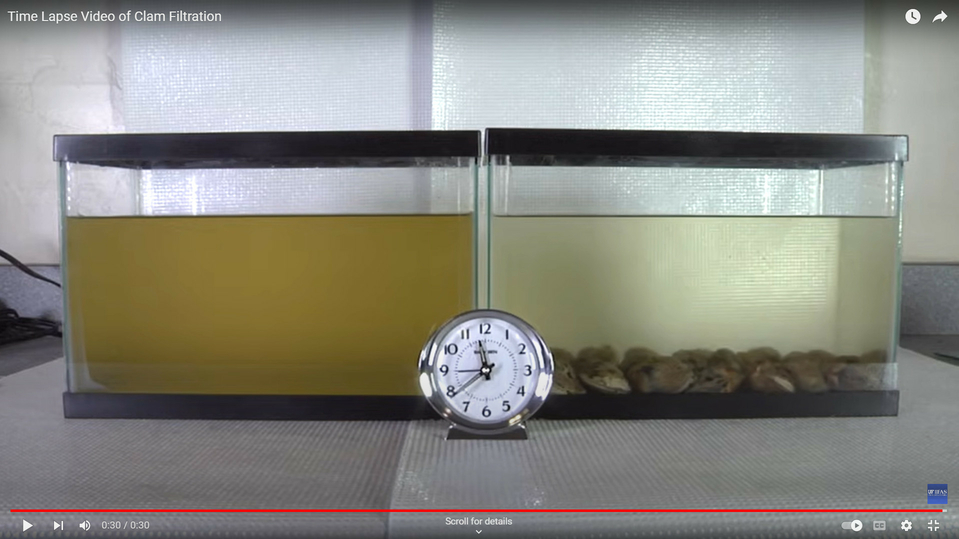
“Hard clams (Mercenaria mercenaria) are filter feeders and, therefore, improve the water quality of the environment in which they are cultured. In this time lapse video, University of Florida/IFAS scientists demonstrate the clam’s water-cleaning efficiency by placing 24 littleneck-size clams in a 2.5 gallon aquarium containing microscopic marine phytoplankton (density of 396,000 algal cells per milliliter). Compare what happens, over the course of 100 minutes, in the aquarium with clams (right) and the aquarium without clams (left). A single littleneck-size clam can filter 4.5 gallons of seawater per day!”
Video by University of Florida/IFAS Solutions: https://www.youtube.com/watch?v=DxEpyjWDB6I
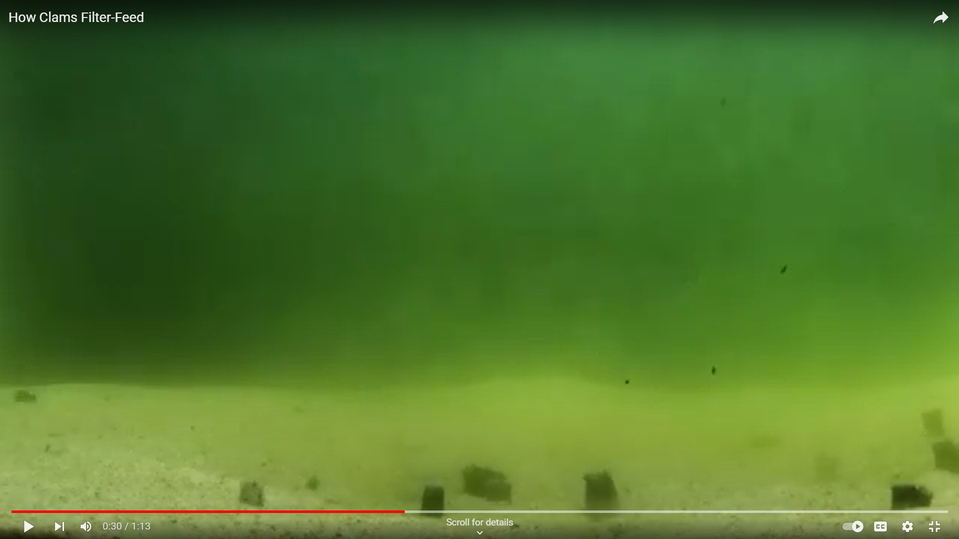
“This short time lapse shows how hard clams burrow, filter-feed and clear up the water”...

Video by Whitney Laboratory for Marine Bioscience, a full-time University of Florida research center for biomedical research and biotechnology: https://www.youtube.com/watch?v=IVZS3UgHdOY
44.04 Giant clams are filter feeders but they mostly feed themselves cultivating microorganisms
Giant clams are filter-feeders but they also cultivate algae in their tissues: they really are just like biosand filters, using both filtration and their own biofilm layer of algae.
“Giant clams are filter-feeders, yet 65-70 percent of their nutritional needs are covered by symbiotic unicellular algae (zooxanthellae). This enables giant clams to grow as large as one meter in length even in nutrient-poor coral-reef waters. The clams cultivate algae in a special circulatory system which enables them to keep a substantially higher number of symbionts per unit of volume.” https://en.wikipedia.org/wiki/Giant_clam

OHorizons’ Biosand water filter in a Bangladeshi family’s home. “How to make a wooden mold for biosand water filters”, by Engineering For Change, an international community of engineers, scientists, non-governmental organizations, local community advocates and other innovators working to solve global development problems: engineeringforchange.org/news/how-to-make-a-wooden-mold-for-biosand-water-filters/

“Tridacninae, common name the giant clams, is a taxonomic subfamily of very large saltwater clams, marine bivalve molluscs in the family Cardiidae, the cockles. This subfamily contains the largest living bivalve species, including Tridacna gigas, the giant clam. They have heavy shells, fluted with 4–6 folds. The mantle is usually brightly colored. They inhabit coral reefs in warm seas in the Indo-Pacific region. Most of these clams live in symbiosis with photosynthetic dinoflagellates.” en.wikipedia.org/wiki/Tridacninae
A bear-paw clam (Hippopus hippopus) observed in Vanuatu (Lonnoc, Santo Island), by Frédéric Ducarme: https://en.wikipedia.org/wiki/Tridacninae#/media/File:Hippopus_hippopus_Vanuatu_01.jpg
44.05 Feeding of the giant saltwater clam Hippopus hippopus:
1 • Nutrition by cultivating symbiotic unicellular algae
“H. hippopus relies heavily on photosynthetic dinoflagellates called zooxanthellae for nutrition. About 65 to 70 percent of a giant clam's nutrition is derived from zooxanthellae. These dinoflagellates are found in the siphonal mantle, and inside a vast tubular system. This tubular system starts at the stomach, where one primary zooxanthellae tube moves through and away from the stomach, branching into two zooxanthellae tubes at the clam's digestive system. Both tubes then travel to the root of the siphonal mantle, where both secondary tubes branch into numerous tertiary zooxanthellae branches. This vast system of tubes allows the zooxanthellae to communicate with the clams stomach through a small opening. A clam's simbiotic relationship with dinoflagellates is unique because the zooxanthellae has a direct relationship with the digestive system of its host.”
2 • Nutrition by filter feeding
“H. hippopus also acquires nutrients through filter feeding, using its inhalant siphon to eat marine microorganisms such as phytoplankton and zooplankton by catching them on ciliated tracts on their gill plates. The amount of carbon a clam acquires using this mechanism is determined by the size of the clam, with smaller clams acquiring approximately 60% of their carbon from this method, and larger clams receiving approximately 34% from filter feeding plankton” https://en.wikipedia.org/wiki/Hippopus_hippopus
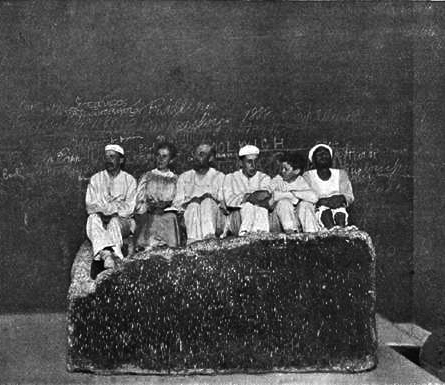
44.06 The “sarcophagus” of the Great Pyramid
At this point, you will probably have no doubt that this holy water font metaphor of a biosand filter is total crap, and I’m not even blaming you; instead I’m blaming again historians and egyptologists who are the ones telling crap, for more than 200 years now.
Because when you tell people that pharaoh Sneferu built three great pyramids all by himself, and that not one of them have a single decoration, writing or painting that would suggest these pyramids had been built as royal tombs, not only you are simply taking people for idiots but you are also taking Sneferu and his architects as idiots as well: in what universe do you think Sneferu would have had three great pyramids built, each one of them taking approximately 20 years to be built by tens of thousands of workers, only to decide not to chose any of them?
And in what universe do you think the stone container, without any single decoration, writing or painting, that have been found in what have been called “the King’s chamber” of the Great Pyramid of Giza, in what universe this “thing” could have been the royal sarcophagus of pharaoh Khufu? This container “thing” is so badly made and damaged that its only purpose we would think of today, would be as a water tank for watering livestock in some remote area.
We’ll see later in this Section that the so-called “sarcophagus” of the Great Pyramid, was the biosand filter of the Pyramid; but first we are gonna talk about sand, and about salt.
The coffer of the Great Pyramid of Khufu: "Great Pyramid Passages" Volume 1, Plate CXXV page 250, by John and Morton Edgar, 1910: archive.org/details/GreatPyramidPassagesVol11910Edition/page/n259/mode/1up
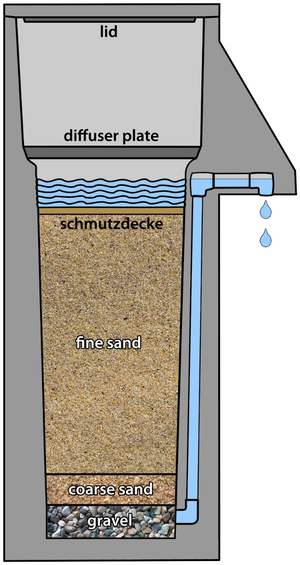
44.07 If some catholic priests are filling up holy water fonts with sand during Lent, it is because fonts are all about a biosand filter
Probably all, at best most of you will completely disregard everything I’m writing right now and everything I’ve already wrote, but it doesn’t matter: next generations will make history by accepting and finishing the job. You think the idea of holy water fonts being glorifications, or celebrations of a biosand filter can only come from a deranged mind? Well, maybe you will change your mind when you will have read this part, because holy water fonts are indeed all about sand.
There are in the United States of America, some churches in which at the beginning of Lent, catholic priests are removing the holy water from the fonts, and they are quite inexplicably replacing it with… sand.
Of course these guys don’t know what they are doing, but at least they still have the knowledge that holy water fonts are all about sand. It looks like the explanation given for filling up the fonts with sand is about remembering people about the desert the first Jews crossed at some point in History; so a lot of priests are getting angry: why the hell would anyone remove holy water from the stoups, at the time of Lent when the need of this holy water is at the highest, only to remind people the Lenten “desert experience”?
If you only want to remind people of the Lenten “desert experience”, you don’t remove the holy water from the fonts and replace it with sand: you put a second font with sand… unless you understand that holy water fonts are in fact beautiful glorifications of a biosand filter.
“Slow sand filters work through the formation of a gelatinous layer (or biofilm) called the hypogeal layer or Schmutzdecke in the top few millimetres of the fine sand layer. The Schmutzdecke is formed in the first 10–20 days of operation and consists of bacteria, fungi, protozoa, rotifera and a range of aquatic insect larvae. As an epigeal biofilm ages, more algae tend to develop and larger aquatic organisms may be present including some bryozoa, snails and Annelid worms. The surface biofilm is the layer that provides the effective purification in potable water treatment, the underlying sand providing the support medium for this biological treatment layer. As water passes through the hypogeal layer, particles of foreign matter are trapped in the mucilaginous matrix and soluble organic material is adsorbed. The contaminants are metabolised by the bacteria, fungi and protozoa. The water produced from an exemplary slow sand filter is of excellent quality with 90–99% bacterial cell count reduction." https://en.wikipedia.org/wiki/Slow_sand_filter
The "Schmutzdecke" is the most biologically active part of a slow sand filter, consisting of a dense population of microorganisms that develops over time and that is key to the disinfection properties of the filter. Cross-section drawing of a biosand filter made of cement, by Alexis Doucet: https://commons.wikimedia.org/wiki/File:Cement_Biosand_Filter_Drawing.png
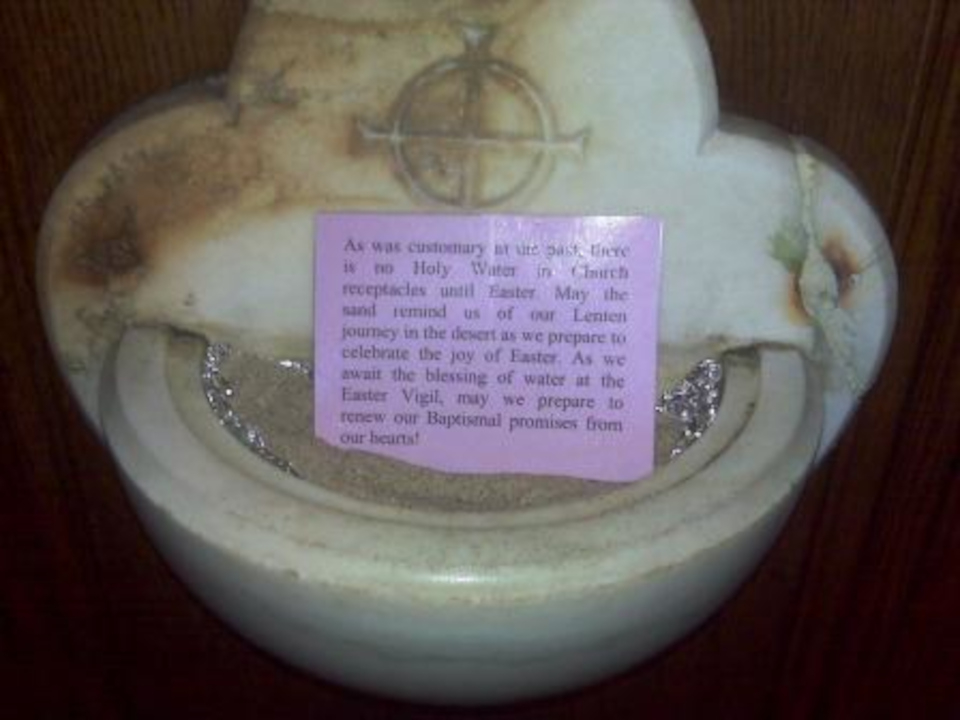
It doesn’t show very well on this picture, but this is sand filling up an aluminum foil protected holy water font.
“You would think that this stupid idea would have been eradicated by now but, no. I am sure that in some places you readers will see that Holy Water has been removed from the stoops – at the beginning of Lent – and replaced with sand. No Holy Water. Sand. This is a REALLY BAD IDEA. If you go into a church where you see this lunatic scheme… for the love of God, do NOT bless yourself with sand.” Stupid Idea: Sand in holy water fonts during Lent. Posted on 5 March 2019 by Father John Zuhlsdorf at https://wdtprs.com/2019/03/stupid-idea-sand-in-holy-water-fonts-during-lent-fr-z-opines/
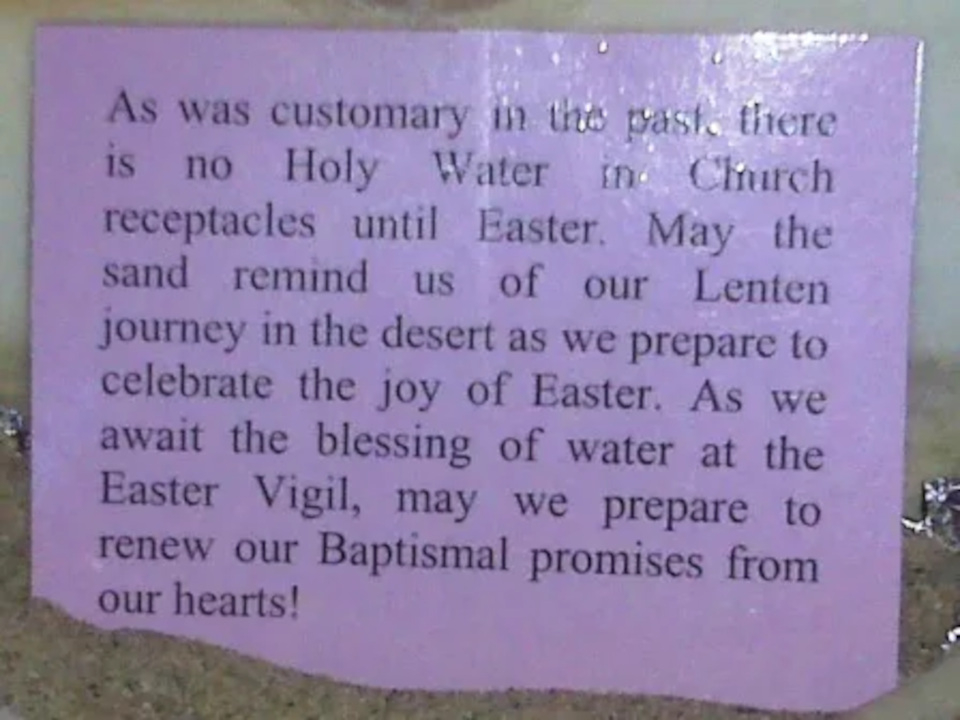
“The abuse of removing Holy Water from fonts during the season of Lent is a manifestation of the Spirit of Vatican II. Well meaning priests misinterpreted or altogether made up their own discipline by removing Holy Water. Father John Zuhlsdorf has followed this up during the course of Lent 2010 with his most recent posting clarifying why Holy Water should never be removed during the season of Lent except for Good Friday and Holy Saturday: “To all the priests out there still… unbelievably still putting sand in holy water fonts during Lent… KNOCK IT OFF! And if you go into a church where you see this sort of idiocy… for the love of God, DON’T bless yourself with SAND.”
Father Zuhlsdorf Rants About Sand in Holy Water Fonts. Posted 2 March AD 2010 at https://the-american-catholic.com/2010/03/02/father-zuhlsdorf-rants-about-sand-in-holy-water-fonts/
“Some parishes remove the holy water from the font during the season of Lent replacing them with sand, stones or even cacti which are symbolic of the Lenten “desert experience”. Some simply cover the font with a purple cloth while others put ashes or simply leave it empty.”
“One parish church in the U.S. provided the following reason: "As was customary in the past there is no Holy Water in the Church receptacles until Easter. May the sand remind us of our Lenten journey in the desert as we prepare to celebrate the joy of Easter. As we await the blessing of water at the Easter Vigil, may we prepare to renew our Baptismal promises from our hearts!"
“In reality, such innovation is praeter legem ("outside of the law") which means that it is not regulated by liturgical law. Although technically not illegal, such innovation is contrary to the Theology of Lent which is not just a season of penance, but also a season rich in the symbolism of water and baptism. Lent is a preparation for Baptism and for renewing our baptismal promise.”
Question: Do we need to remove Holy Water during Lent? Posted June 16, 2011 at http://prieststuff.blogspot.com/2011/03/holy-water-during-lent.html
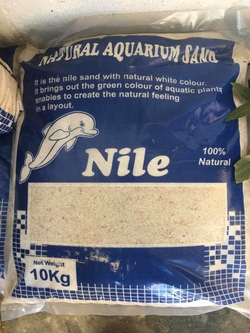
44.08 If the sand that was inside the biosand filter of the Great Pyramid was coming from the Nile river's bed, it would explain the metaphor of the Nile passing through the entire Pyramid's internal layout: Nile water is indeed rain water… collected by the river bed itself
I’ve already talked about the problem of what kind of water was used inside the Great Pyramid to achieve evaporative cold: was it water from the Nile or rain water collected on the operational flat roof of the Pyramid (just like a mastaba).
The water from the Nile was my first assumption, of course because of the importance of god of the Nile Hapi; but as time went by, I also started to understand the importance of the metaphors in the ancient Egyptian religion, and in particular the one assimilating the internal layout of the Pyramid to the country of Egypt itself: if there is a Upper and Lower Egypt, it is only because there was a Upper and Lower Great Pyramid.
In previous Sections I ended up finding out what really was the separation between the Lower and Upper part of the Pyramid, and that is the place where the four Egyptian pulley wheels that were installed onto the top platform of the Gallery. The base of the pulleys made of stone (probably granite, and which had been glorified into the persons of Abram and Abraham), and their cylindrical stone “wheels” (which had been glorified into the persons of Sarai and Sarah), they are the separation.
So we have some kind of water which relentlessly fed the Great Pyramid, for who knows how long, and which was running through its entire internal layout, from top to bottom; starting as liquid water in the King’s chamber and in the filter, and ending up as vapor when expelled from the Queen’s chamber.
Of course, it is tempting to imagine that water to be water from the Nile, but why bother getting all the water needed from the river when you simply had to collect rain water? By doing so, you avoid the hard work and you get better quality water, all at the same time.
I personally think now that it was indeed rain water that had been used; and there is another point to take into consideration, and that is the biosand filter itself; because if the sand which was inside that filter was coming from the river bed of the Nile, then you have the perfect metaphor of the Nile: Nile water is indeed, rain water collected by the river bed.
Egyptian Nile river sand from Dream Aqua: https://www.facebook.com/101004668060498/posts/nile-sand-now-available-100-natural10kg-bag-rs1450-only-1kg-rs195/211884900305807/

“Some poor parisheners are suffering this from the “progressive” and trendy practice of emptying holy water fonts and baptismal fonts during Lent. Some parishes have even been known to fill the font with sand after the water is emptied out. I guess this is to symbolize the desert. Clever, trendy, but not in line with the teaching and instruction of the Church. Hopefully, fewer parishes each year are playing with unacceptable and silly innovations. On a recent Catholic Answers Live segment Jimmy Akin called this kind of new practice a “stupid” idea, if I remember correctly.” https://catholicconvert.com/parish-holy-water-fonts-empty-full-of-sand/
44.09 The progressive and inexorable lost of knowledge still in action… right now
I would be surprised that some extensive and reliable studies have been made regarding the replacement of holy water by sand during Lent, but if Steve Ray is correct, saying that this usage is progressively less and less observable in the US, it is simply the perfect illustration of the inexorable progressive lost of knowledge which would end up in a few centuries with the complete oblivion of the true origin and the true meaning of the 3 Abrahamic religions.
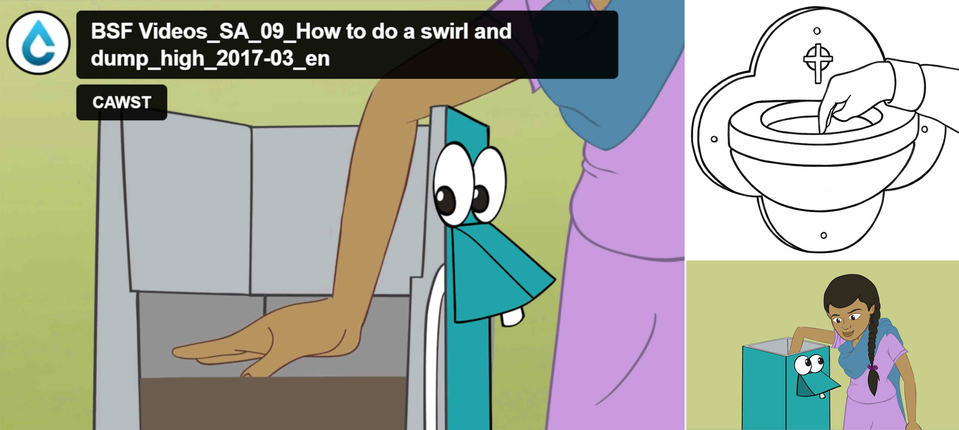
Maintenance of a biosand filter: How to do a Swirl and Dump. Biosand filter videos by CAWST*: https://washresources.cawst.org/en/resources/db9a2240/9-how-to-do-a-swirl-and-dump-biosand-filter-videos
Holy water font coloring page: https://www.thecatholickid.com/hand-holy-water-font-coloring-page-cnt-mls/
44.10 From the swirl cleaning movement to the sign of the Cross: the biosand filter wet harrowing cleaning method... so that everybody entering the church can participate in assuring high efficiency filtration
This is certainly one of the most important and beautiful deciphering you will find in this study: why do Christians put they hands in holy water and then make the sign of the Cross with that same hand.
Until now, I’ve only discussed of the purpose and the capabilities of biosand filters, and the fact that holy water fonts are directly referring to that filter; but in real life, the filter doesn’t work all by itself without any care: there is some maintenance to do to assure the highest efficiency of the filtration.
In short, after having take some of the water out of the filter, you have to literally put your hand in the filter, right inside the water and gently move your hand above the sand in all directions: you need to move your hand left and right, top to bottom, and all that just above the sand, in shallow water. And it is recommended you do this gesture three times in a row.
If you put your hand in the holy water font that is the glorification of a biosand filter, and if you move that hand which is wet by the holy water itself, in the four directions… it is because you are demonstrating that you are actively participating in the maintenance of the filter, hence the strength of the community which would never run out of potable water.
And there is all the beauty of the Sign of the Cross: every single believer entering the church, by putting his hand in the holy water font and making the Sign, claims and affirms that he is actively participating in the strength of the church; of course, the more people will enter the church and the stronger will be the Church.
"Slow sand filters slowly lose their performance as the biofilm thickens and thereby reduces the rate of flow through the filter. Eventually, it is necessary to refurbish the filter. Two methods are commonly used to do this. In the first, the top few millimetres of fine sand is scraped off to expose a new layer of clean sand. Water is then decanted back into the filter and re-circulated for a few hours to allow a new biofilm to develop. The filter is then filled to full volume and brought back into service. The second method, sometimes called wet harrowing, involves lowering the water level to just above the hypogeal layer, stirring the sand; thus precipitating any solids held in that layer and allowing the remaining water to wash through the sand. The filter column is then filled to full capacity and brought back into service. Wet harrowing can allow the filter to be brought back into service more quickly.” https://en.wikipedia.org/wiki/Slow_sand_filter
*CAWST is a Canadian charity and licensed engineering firm. “We address the global need for safe drinking water and sanitation by building local knowledge and skills on household solutions people can implement themselves.”
Everything you need to know about biosand filters in 9 animated instructional videos on the operation and maintenance of the biosand filter (BSF), by CAWST. These videos have been designed to educate end users of the filter and as a resource for organizations distributing the filter: https://washresources.cawst.org/en/collections/dff54fff/biosand-filter-use-and-maintenance-videos
“How to do a Swirl and Dump (That's what you do if the water is flowing much slower than usual from the biosand filter): 1 • First, take off the lid, then pour water into the filter until its' above the level of the diffuser. Once the water is at this level, take out the diffuser. 2 • Stick your hand into the filter until your hand is flat on the sand. 3 • Swirl the surface of the sand around three times. 4 • Then scoop out the dirty water with a cup or bucket. And make the top of the sand flat and level.
Source CAWST: https://washresources.cawst.org/en/resources/0154ec50/transcripts-for-9-how-to-do-a-swirl-and-dump-biosand-filter-videos

An image from a Catholic children's catechism shows the correct method for making the Sign of the Cross.
44.11 Metaphorically, everything is reversed: the more people there are to put their hands inside the holy water, and the more the biosand filter is well maintained and able to take care of the microbial problem
This idea that holy water fonts are glorifications, or celebrations of a biosand filter supplying potable water to the community (even if really and originally referring to the Great Pyramid), is actually perfectly known: numerous scientific papers are pointing out the problem.
But, the fact is that there isn’t really a problem: if holy water is potentially source of pathogenic microorganisms, it is actually made in purpose. Of course, in real life, the more people are putting their hands inside the holy water, the higher the risk, but this is not real life we are talking about here; this is spiritual life, or should I say it only is metaphorical.
Metaphorically, the more people there are to put their hands inside the holy water, and the more the biosand filter is well maintained and able to take care of the microbial problem. Metaphorically, everything is reversed.
Below is a very important study which claims that the addition of salt to holy water, doesn’t take care of the microbial problem that is developing inside the holy water fonts. Salt isn’t added to holy water for its microbial stability, indeed.
"The effect of salting on the bacterial load of holy water from catholic churches", by Martina Turk, Vesna Podgrajsek, Nina Gunde-Cimerman; BABEŞ-BOLYAI University, Romania.
Abstract: "Holy water plays an important role in various religions. It is also recognized as a source of potentially pathogenic microorganisms. The holy water was linked to human infections caused by Pseudomonas aeruginosa, Acinetobacter baumanii, Escherichia coli, and other enterobacteria. In the Roman Catholic Church salt can also be blessed for use as a sacramental and is sometimes added to holy water. Holy water is kept in fonts usually located at the entrance to the church to enable people to bless themselves with it on entering, potentially introducing their skin microbiota into the water in the process of doing so. In order to better understand the influence of salt addition on the bacterial community of holy water and the potential risk posed by this water as a source of infection with pathogenic microorganisms, we studied the composition of cultivable aerobic bacterial community in holy water from fonts and reservoirs of selected Catholic churches in urban areas. Large part of isolates were typical human skin commensals from the genus Staphylococcus followed by Pseudomonas isolates. Selected isolates were also tested for resistance to antibiotics. The addition of salt is not sufficient as a prevention against microbial contamination of holy water. Appropriate hygiene measures like regular water exchange and a thorough cleaning of the fonts should be used regardless of the addition of salt". http://studia.ubbcluj.ro/arhiva/abstract_en.php?editie=BIOLOGIA&nr=1&an=2019&id_art=16839
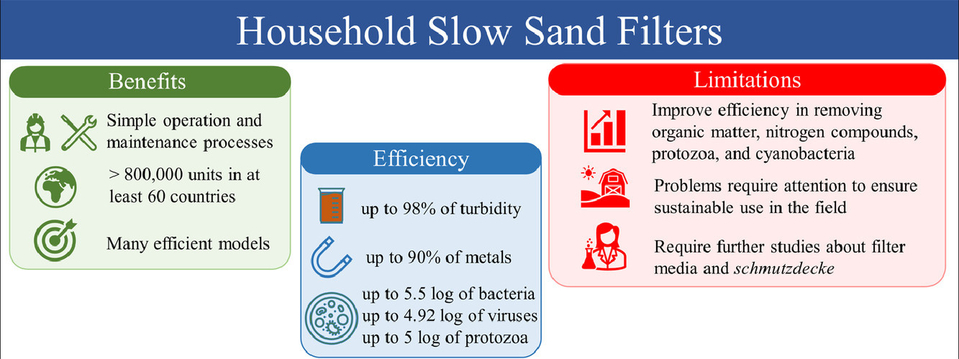
Benefits and limitations of Household Slow Sand Filters (HSSF), also known as Biosand Filters: https://ars.els-cdn.com/content/image/1-s2.0-S0043135421010642-ga1_lrg.jpg
44.12 Nth mea culpa: biosand filters do not soften water, they don’t get rid of dissolved salts
At first, I really didn’t understand why holy water was added with salt, because for some reason I thought a biosand filter was getting rid of dissolved salts, and it didn’t make any sense: if the biosand filter of the Great Pyramid was supplying softened water, why would holy water be salted water?
And then, I realized I was wrong: biosand filters and slow sand filtration in general (biosand filters are only household slow sand filters, HSSF), simply do not filter dissolved salts. I’m sorry, because it was a very big mistake, Mea culpa, again.
44.13 Biosand filters only remove pathogens and suspended solids from water: they do not soften water…
“A biosand filter (BSF) is a point-of-use water treatment system adapted from traditional slow sand filters. Biosand filters remove pathogens and suspended solids from water using biological and physical processes that take place in a sand column covered with a biofilm. BSFs have been shown to remove heavy metals, turbidity, bacteria, viruses and protozoa.” https://en.wikipedia.org/wiki/Biosand_filter
“The biosand filter has been studied in the field and in labs. It has been shown to remove the following from contaminated water: up to 100% of helminths (worms), up to 100% of protozoa, up to 98.5% of bacteria and 70-99% of viruses. The filter can also remove up to 95% of turbidity (dirt and cloudiness), and up to 95% of iron (which people often don’t like because it turns water, laundry and food red!). Like other filters, the biosand filter cannot remove dissolved contaminants or chemicals, such as salt, arsenic or fluoride.” https://www.cawst.org/services/expertise/biosand-filter/more-information

Salt for water softener's illustrations thanks to: https://waterfilterguru.com/where-to-buy-salt-for-water-softener/ and https://www.janitorssupplyco.com/product/water-softener-salt-50-wss50/
44.14 But salt (NaCl) is the most commonly agent used to soften hard water...
The basic idea is to exchange the hard minerals like calcium (Ca) with soft minerals like sodium (Na), by using simple table salt NaCl (Sodium Na + Chlorine Cl).
“Water softeners treat hard water by using salt and ion-exchange resins to remove calcium and magnesium hardness from the water, which can cause scaling and buildup in plumbing and appliances. The most common method used by water softeners is ion exchange. This process works by replacing the hard water minerals with soft water minerals, such as sodium or potassium. Water softeners typically use resin beads that are coated with the softening agent, most commonly a sodium solution. When the hard water passes through the resin bead, the calcium and magnesium ions are attracted to the resin bead, and the sodium ions are released into the water.” https://www.freedrinkingwater.com/whole-house/water-filter-knowledge-base/water-softening-vs-water-filtration.htm
44.15 And this is why holy water is actually made by adding "Blessed salt" to plain water
“Blessed salt has been used in various forms throughout the history of Christianity. Among early Christians, the savoring of blessed salt often took place along with baptism. In the fourth century, Augustine of Hippo named these practices "visible forms of invisible grace". However, its modern use as a sacramental remains mostly limited to its use with holy water within the Anglican Communion and Roman Catholic Church.” https://en.wikipedia.org/wiki/Blessed_salt
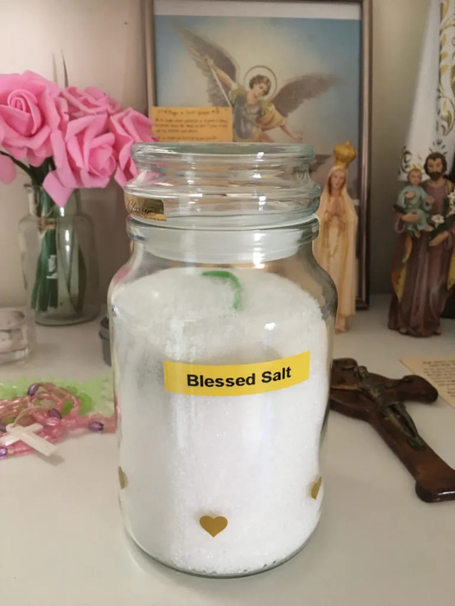
44.16 How to Make Your Own Holy Water*
"Gather and consecrate your salt. You will need to create holy salt before you can create holy water, so consecrate the salt (i.e. make it sacred or holy) first. Take some pure salt (e.g., Kosher salt or natural rock salt with no added ingredients) and add it to a container, such as a small bowl or jar. Once you are ready to bless the salt, say the following words from The Roman Ritual:
“Our help is in the name of the Lord, who made heaven and earth. O salt, creature of God, I exorcise you by the living God, by the true God, by the holy God, by the God who ordered you to be poured into the water by Eliseo the Prophet so that its life-giving powers might be restored. I exorcise you so that you may become a means of salvation for believers, that you may bring health of soul and body to all who make use of you, arid that you may put to flight and drive away from the places where you are sprinkled every apparition, villainy, and turn of devilish deceit, and every unclean spirit, adjured by Him Who will come to judge the living and the dead and the world by fire. Amen.”
If you are consecrating the salt in front of witnesses, invite them to join you in prayer: “Almighty and everlasting God, we humbly implore Thee, in Thy immeasurable kindness and love, to bless and sanctify this salt which Thou did create and give over to the use of mankind, so that it may become a source of health for the minds and bodies of all who make use of it, and may rid whatever it touches or sprinkles of all uncleanness and protect it from every assault of evil spirits. Through our Lord, Jesus Christ, Thy Son, Who lives and reigns with Thee in the unity of the Holy Spirit, God, for ever and ever. Amen.”
There are no special requirements for the container you use for the salt. If you keep any holy salt that you do not mix with the water, make sure you mark the container so you don’t confuse it with regular table salt."
*How to make your own holy water, co-authored by M. Lorenz, PhD: wikihow.com/Make-Your-Own-Holy-Water

44.17 The perfect metaphor of the “exorcised” salt added to holy water: exorcism really is filtration
I don’t know if many people know in the first place that holy water is most of the time plain water simply added with salt, and actually I didn’t know that myself; but what is important and so beautiful, is the term that has been chosen to qualify that salt: we are talking about “exorcised salt”.
The problem is that we are all collectively victims of what I’ve called the Great Renouncement: it is like nobody is studying the Bible with a true opened mind and a simple scientific approach: it isn’t normal I’m the first one to describe Ezekiel’s Wheels within the Wheels and his Four Living Creatures as simple Egyptian pulleys put into motion with simple ropes, and it isn’t normal either I’m the first one to apparently look at the whole “exorcism” thing without any preconceived ideas.
Just think it through: what really is exorcism in simple words? When it is mentioned someone is being possessed by a demon, for example. What happens next?
Well, in simple words the problem is that you have “something” that doesn’t belong to the person, and you just want to take it out: you want to “pull” the demon “out” of the person, in other words you need to “extract” the demon out of the body of the person.
Well that my friends, is the real definition of the process of filtration itself.
In other words, just like everything we’ve already seen until today, all these metaphors about the reinterpretations and the glorifications of the ancient scientific and technological knowledge, the idea of “exorcism” is another of these metaphors, and it stands for the filtration process.
“Sprinkling with holy water is used as a sacramental that recalls baptism In the West the blessing of the water is traditionally accompanied by exorcism and by the addition of exorcised and blessed salt.” https://en.wikipedia.org/wiki/Holy_water
“Exorcism (from Ancient Greek ἐξορκισμός (exorkismós) 'binding by oath') is the religious or spiritual practice of evicting demons, jinns, or other malevolent spiritual entities from a person, or an area, that is believed to be possessed. Depending on the spiritual beliefs of the exorcist, this may be done by causing the entity to swear an oath, performing an elaborate ritual, or simply by commanding it to depart in the name of a higher power. The practice is ancient and part of the belief system of many cultures and religions.” https://en.wikipedia.org/wiki/Exorcism
Painting of Saint Francis Borgia performing an exorcism, as depicted by Francisco Goya: https://en.wikipedia.org/wiki/Exorcism#/media/File:St._Francis_Borgia_Helping_a_Dying_Impenitent_by_Goya.jpg

“Eliseus pouring salt on the waters of Jericho.” Slightly edited for enhanced clarity, from The Rijksmuseum, Amsterdam: https://www.rijksmuseum.nl/en/collection/RP-P-1982-306-217
44.18 Blessed Salt is indeed meant to purify water
The important word here, of course is “purify”, because when “purify” is about water, what everybody should hear is “filter”: to purify water, what you need is to filter that water.
“Holy Water, Rosaries, Scapulars, Crucifixes, but... salt? Yes, surprisingly to many, a powerful yet forgotten sacramental exists which is none other than Blessed Salt. A few weeks ago I visited a parish that actually had containers of salt near the front door that were blessed. They asked for a very minimal donation of only 40 cents per 26 oz Iodized Salt container like you would find at the grocery store. They noted on the top of the salt containers that they were all blessed by the priest with the special blessing reserved for salt. I happily picked up one, made a donation, and parceled it out to several people in small containers. Blessed Salt is a Sacramental that needs to make a comeback in the Church. In fact, I see very few traditional Catholic parishes that even make it available.
Blessed Salt is a powerful Sacramental. The Rituale Romanum blessing of Holy Water, in fact, required exorcized salt. […] Why was it done? The practice of putting salt into the water comes no doubt from the incident of the miraculous cure of the poisonous well (see 4 Kings 2.19-21), where the prophet Eliseus used salt to purify the water of the well.” The Forgotten Sacramental: Blessed Salt, by A Catholic Life: https://acatholiclife.blogspot.com/2019/01/the-forgotten-sacramental-blessed-salt.html

44.19 The problem of the water softening process with sea salt: how exactly... and where did that happened?
The fact that the holy water is actually salted water poured inside the celebration of the biosand filter, could indicate that the addition of sea salt for the water softening process occurred before the water got filtered; but of course this part is completely out my reach.
The only thing I could add, is about the antechamber of the King’s chamber, just next to where was set the operating biosand filter, and which is now the electrical room of the Great Pyramid.
It is funny, because when you think about it, this room was the “technical room” of the Pyramid, 4,500 years ago, and it is still one today; only the technology changed over time.
A few months ago, I thought there wasn’t four but only three ropes in the Grand Gallery, and I thought the antechamber would be for their storage over night of for longer periods of time; but now that it is certain that there were really four ropes (because of the Four Wheels within the Wheels of Ezekiel and the Four Living Creatures with only one straight and rigid leg, the ropes really), the antechamber is pretty much losing that storing purpose.
Also, the more I think about it, the more I believe the ropes stayed in place in the Gallery, at all time; so maybe the antechamber was part of the softening process; but this is just a suggestion.
Typical Water softening process: inspectapedia.com/plumbing/Water-Softener-Parts-Schematic-HellenbrandE2.jpg

44.20 The up to one-half inch thick salt incrustation in the Queen's chamber & the horizontal passage
The salt encrustation inside the Great Pyramid has been mainly documented in the Queen's chamber, where it could have been up to one-half-inch thick in some places, 1.3 centimeter, and in the horizontal passage, but also in a smaller extent in the lower part of the Grand Gallery and in the ascending passage.
There is no salt encrustation documented anywhere else, and its distribution is perfectly explained by the evaporative process and the particular layout of the junction between the Grand Gallery, the ascending and horizontal passages.
The following excerpt is from "Great Pyramid Passages Vol 1, 1910 edition" by John and Morton Edgar, paragraph ref. 584, page 293 : https://archive.org/details/GreatPyramidPassagesVol11910Edition/page/n301/mode/2up
Paragraph. ref. 584 : "Following these uniform sets of 15 stones, are two long stones in each course, averaging about six feet in length, after which each wall is built in one course only, apparently as far at least as the drop in the floor of the passage ; but beyond this, on to the Queen's Chamber, the very thick and hard incrustation of salt which entirely covers the walls of this passage, made it impossible for us to locate the joints with any certainty. This salt incrustation is peculiar to the Horizontal Passage and Queen's Chamber, although a little of it may also be seen on the walls of the First* Ascending Passage."
* For some authors, the first ascending passage starts at the granite plugs and ends with the start of the Grand Gallery, the second ascending passage.
Excerpt from "The pyramids and temples of Gizeh" by Petrie, W. M. Flinders (William Matthew Flinders), Sir, 1853-1942 : "The size of the chamber (after allowing suitably in each part for the incrustation of salt) is on an average 205 85 wide, and 226*47 long, 184*47 high on N. and S. walls, and 245*1 high to the top of the roof ridge on E. and W. walls." https://archive.org/details/cu31924012038927/page/n103/mode/2up
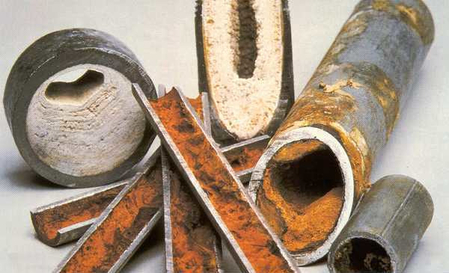
The cleaning of the salt deposits is actually a real drama, because before 1998 it was still possible to know exactly at what temperature the Queen's chamber was cooled down, simply by analyzing the crystalline structure of the deposits, the size and shape of the crystals.44.01 Salt encrustation is the signature of the evaporative cooling process... even nowadays
Of course, the salt encrustation in evaporative cooling systems is not about table salt NaCl, but primarily calcium carbonate CaCO3 also called calcium scale, or limescale.
With most of the pyramid built with limestone, this is not a surprise that limescale would have been a major problem.
From "Evaporative Cooler : Self Salt Clean", by Mohammed Ali Bahobail from the Department of Architecture and Building Sciences, College of Architecture and Planning, King Saud University, a Public university in Riyadh, Saudi Arabia : "Evaporative coolers are relatively economical, less expensive to install and to operate. They are consuming less electricity than a refrigerated unit, and they do not need an expert to maintain. In addition, evaporative coolers provide the building with a fresh humid air. However, evaporative coolers have some disadvantages; one of them is the deposited salt. Water usually has a high percentage of mineral. The evaporative mechanism will leave mineral deposits on the pads and interior of the cooler. This cumulative mineral will close the porous of the wetted pads and damage them and will participate to corrosion of the cooler frame."
The work made by Mohammed Ali Bahobail is about coolers designed with wetted pads where water is circulating, there is no fog of microdroplets, but the principle is the same and the deposited salt problem is the same. https://cap.ksu.edu.sa/sites/cap.ksu.edu.sa/files/imce_images/jap_ksu_jan2013_e1_0.pdf
44.21 The 12 months of cleaning the hard salt encrustations in 1998
Unfortunately, the salt deposits have been removed since the first explorers of the pyramid reported its presence, most likely when the chamber was cleaned by Zahi Hawass in 1998 :
Zahi Hawass (Director General of the Giza Pyramids, between 1987 and 2002) : "Each visitor produces nearly an ounce of moisture with a high saline content through their breath and perspiration. This results in the accumulation of salt, which leeches into the limestone and plaster and gradually causes them to crumble into powder. So, in 1998, we spent 12 months cleaning the salt."
Excerpt from https://www.world-archaeology.com/features/pyramids-excavation-and-preservation/
Mr Hawass is obviously blaming tourists for the salt encrustations in the Queen's chamber, but when the first explorers of the pyramid discovered these encrustations, there wasn't any tourist at all visiting the pyramid. The remark of Mr Hawass, is pretty funny though : did we ever had to periodically close down limestone built churches, cathedrals or any other pyramid or building made of this material (I guess in Mr Hawass' mind, limestone is a key element of the salt deposits in the Great Pyramid), just to remove the salt? Be that as it may, salt deposits were only documented in the Grand Gallery in its lower part (most probably just around the junction with the horizontal and ascending passages); did tourists stop breathing passed this point, and did they climb the gallery and visit the King's chamber in total apnea ? Were they offered respiratory masks ?
The cleaning of the salt deposits is actually a real drama, because before 1998 it was still possible to know exactly at what temperature the Queen's chamber was cooled down, simply by analyzing the crystalline structure of the deposits, the size and shape of the crystals.

Internal layout of the Great Pyramid of Giza, showing the Queen's chamber on the left, the horizontal cooling passage and the connection with both the Grand Gallery and the ascending passage (the inclined well).
44.22 The structure adaptation against shock cooling in the evaporative passage
In the above drawing of the horizontal passage of the Great Pyramid, the red arrow indicates the exact location where the small blocks of the beginning of the passage are being replaced by regular size blocks. Small blocks, along with continuous and larger joints filled with what had been described as resin or tar, is the consequence of a structural adaptation against thermal stress of the structure. Because there is no sign of burning anywhere, the thermal stress only had to be about cold.
It means that after this point, the shock cooling was considered negligible by the architects of the Pyramid.
More on the subject in Section 1: the-pyramids-of-the-cold-v2/section-1-evaporative-cooling-passage.html
44.23 The propagation of the cold from the horizontal cooling passage to the lower end of the Grand Gallery
There is an excerpt talking about the distribution of the salt deposits inside the Great Pyramid at the time of Petrie, before it has been cleaned out by Zahi Hawass in 1998.
Just like Petrie and the Edgar brothers had discovered, the most important salt deposits were located inside the Queen’s chamber as well as in the Horizontal passage, but less important deposits had been reported in the lower part of the Grand Gallery (see below), as well as somewhere inside the Ascending passage (I read it about 2 years ago, but couldn’t find the excerpt anymore); of course it would have to be in the upper part of this particular passage, but I don’t remember this information was given by the author.
“[…] salt encrustation was discovered in the Queen's Chamber when it was first opened: one of the greatest mysteries of this chamber has been the salt encrustation on the walls. It was up to one-half-inch thick in places, and Petrie took it into account when he made measurements of the chamber. The salt also was found along the Horizontal Passage and in the lower portion of the Grand Gallery. How did salt come to build up on the walls?” Pyramids and Temples in Egypt, by Coen Vonk: https://www.theosociety.org/pasadena/sunrise/52-02-3/eg-vonk.htm

Operation of the Great Pyramid of Egypt at Giza, for evaporative cold production. Last updated: October, Sunday 22, 2023. Corrections on the biosand filter not softening the water, and the antechamber of the King's chamber as an hypothetical softening chamber.
44.24 The operation of the Great Pyramid of Giza
Operation of the Great Pyramid of Egypt at Giza, for evaporative cold production by flash evaporation of water inside the horizontal passage, resulting in massive salt deposits in the cooled down parts of the Pyramid (the horizontal cooling passage, the Queen's chamber, the lower end of the Grand Gallery and (supposedly the upper part of the ascending passage/inclined well).
44.25 There really were two concerns about the efficiency of the evaporative cold process 4,500 years ago, just like there are today: salt deposits (scale) and microbiological growth
"When an evaporative cooling system rejects heat to the atmosphere, only pure water is evaporated. As this occurs, the dissolved ions—naturally occurring in the makeup water source—are left behind. Without proper water treatment, the dissolved ion concentration increases as evaporation continues and, at some point, will reach saturation of the ions, which can lead to scale. The most common form of scale is calcium carbonate. Preventing scale via water treatment impacts the efficiency of heat transfer, thereby reducing energy consumption of the entire system."
"Microbiological growth in evaporative systems can lead to accelerated corrosion rates, heat transfer deficiencies due to biofilm, as well as human health related concerns. There are a variety of reasons why one system may experience higher biological activity than another. Tower location, nearby construction or farming operations, the makeup water source, and more can all lead to an increased level of bacteria in the water."
Excerpts from the website of EVAPCO, Westminster, Maryland, United States : https://www.evapco.com/faq/answer/water-treatment-evaporative-cooling-system
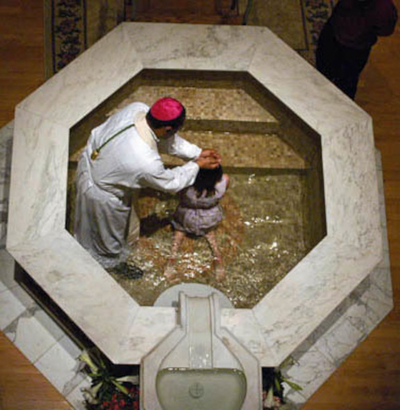
44.26 The other celebrations of the (filtered and softened) water that powered up the Great Pyramid
What we’ve seen so far in this Section, is the Christian celebration of the treatment that had been applied to the water that was used inside the Great Pyramid of Egypt in order to create the evaporative cold: the biosand filtration to produce potable water and get rid of the microbial problem, and the softening of that water with salt to get rid of the salt deposits problem.
In short, Holy water is the glorification of the water that powered up the Great Pyramid to create the cold.
But Christians didn’t stop here in their celebration of that water: they also perform Baptism, the sprinkling of Holy water and the burning of incense.
1 • Baptism by total immersion
Even if rare and obviously not really encouraged, baptism by immersion should be actually mandatory: "While it is true that the basic root meaning of the Greek words for baptize and baptism is immerse/immersion, it is not true that the words can simply be reduced to this meaning, as can be seen from Mark 10:38–39, Luke 12:50, Matthew 3:11 Luke 3:16 and Corinthians10:2." https://en.wikipedia.org/wiki/Baptism
Once the water got out of the filter, it then filled up the inclined well so that the impactor would pressurized the water. The Baptism by immersion is simply the celebration of the exact moment when the impactor is getting into the waters of the inclined well.
It is very interesting here, because both the person to be baptized and the priest are getting into the water; and though it might be risky to try to decipher everything, let’s say that it may be some kind of reinterpretation of the composite impactor: the same way its wooden part was only the vessel used to move the Osiris stone, the priest performing the baptism, the initiator, could also be seen as that vessel, a simple tool used by the baptized. But, maybe I’m trying too hard here.
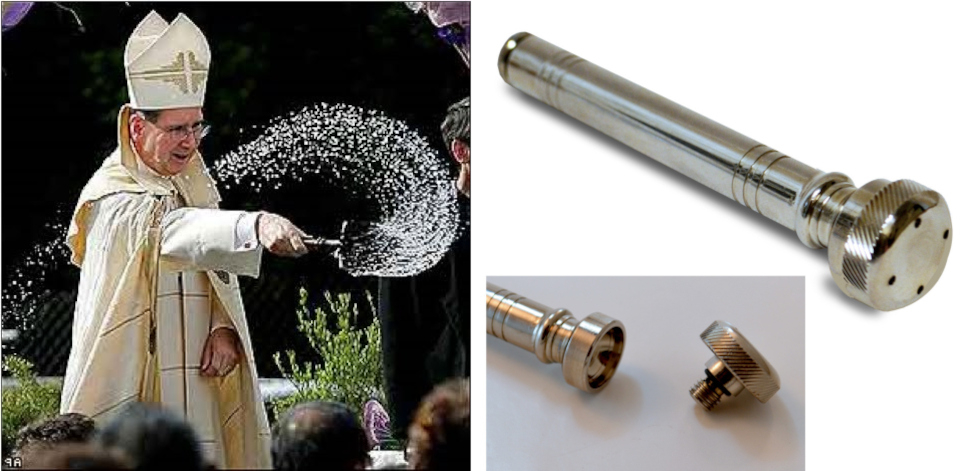
The sprinkling of Holy water, using an Aspergillum, by Roger Michael Cardinal Mahony KGCHS (born February 27, 1936), an American cardinal and retired prelate of the Catholic Church who served as Archbishop of Los Angeles from 1985 to 2011: https://en.wikipedia.org/wiki/Roger_Mahony, hence creating and projecting numerous droplets of water. Example of a holy water sprinkler: https://stpatricksguild.com/5-silver-holy-water-sprinkle/#gallery
2 • The creation of numerous droplets of holy water from pressurization in a sprinkler
Now that we are getting very close to the climax of the operation of the Great Pyramid with the creation of the evaporative cold itself, it is time to talk about what probably is the most iconic gesture of catholic priests: the sprinkling of Holy water.
It is actually exactly the same reasoning than the one about the giant clam shells: if you aren’t interested in finding out the truth, you won’t be willing to see these shells as nothing else than what they are and you absolutely will not try to understand the living animal and what are its extraordinary capabilities.
The same way, when you look at a priest sprinkling Holy water through this weird thing that looks like a tea ball, you won’t try to analyze the whole thing, and you won’t understand the priest is pressurizing the sprinkler “tea ball” only to produce a vast number of droplets of water.
The sprinkling of Holy water is only about this: droplets of water produced after pressurization and projected in front of the priest; and of course this sprinkling thing is only the celebration of the pressurization of the inclined well and the creation of droplets of liquid water that occurred inside the horizontal passage of the Great Pyramid.

The creation of a cloud of smoke by burning incense: http://expo.pravoslavie.ru/expo/photogallery/312.html
3 • The burning of incense and the production of a cloud of smoke (i.e. a fog)
Now that we have the creation of the droplets of liquid water, it would have been even better if our ancestors would have been able to represent the fact that it wasn’t just regular droplets of water, but very tiny microdroplets of water… and that is what they did with the incense burning.
Of course you can focus yourself on many things when burning incense, specially inside doors where the smell will be heightened; but the fact is that the only reason of priests burning incense is to produce a cloud of smoke; because that cloud of smoke is only the celebration of the fog of microdroplets.
This is why there are two priests: one creating the droplets of water, and one creating the cloud of smoke/fog. You have to combined the two of them to understand the whole thing.

“How Fogging Works”, by Microcool, Thousand Palms, California. “For centuries, the principle of flash evaporative cooling has been used to combat heat and add humidity. MicroCool melds this age-old principle with the very latest technology to create advanced solutions for controlling humidification in a variety of applications.” https://www.microcool.com/equipment/industrial-fogging-technology/
44.27 The transformation of pressurized water into a fog of microdroplets
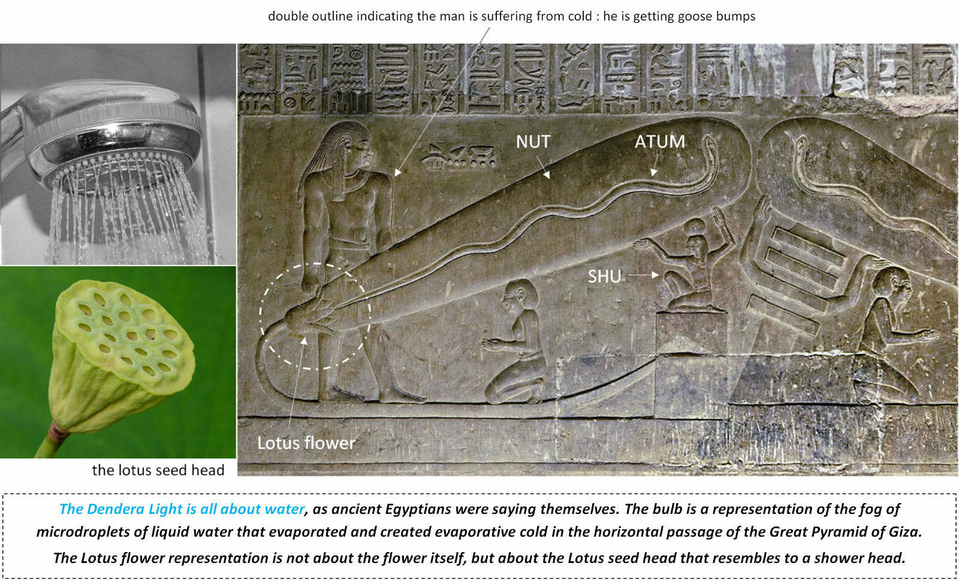
Lotus seed head photograph by Dinkum: commons.wikimedia.org/wiki/File:Nelumbo_nucifera_%28fruit%29.JPG
44.28 The perfect drawings of the fog of microdroplets by the ancient Egyptians themselves: the Dendera Light
"The Dendera Light is a stone relief in the Hathor temple at Denderah in Egypt, that depict Harsomtus, in the form of a snake, emerging from a lotus flower. "In six reliefs he is shown within an oval container called hn, which might represent the womb of Nut. These superficially resemble a lamp or light." Photograph thanks to Kairoinfo4U and posted on flickr: https://www.flickr.com/photos/manna4u/14525094039/in/photostream/
44.29 The Dendera Light is indeed described by ancient Egyptians themselves as in a "magical" liquid form
The fact that the Dendera Light is made of liquid water that transforms itself in a magical way, is exactly what are describing ancient Egyptians themselves: [About the snake inside the Dendera Light Bulb] "The field surrounding Ra’s snake form is referred to in ancient Egyptian literature as protective magical energy in liquid form that all gods and pharaohs possess (Faulkner 1970*)." https://ahotcupofjoe.net/2016/11/dendera-light-bulb-and-bagdad-battery-nonsense/
*I'm not sure, but the excerpt might be from "The ancient Egyptian book of the dead / translated by Raymond O. Faulkner ; edited by Carol Andrews, 1972."
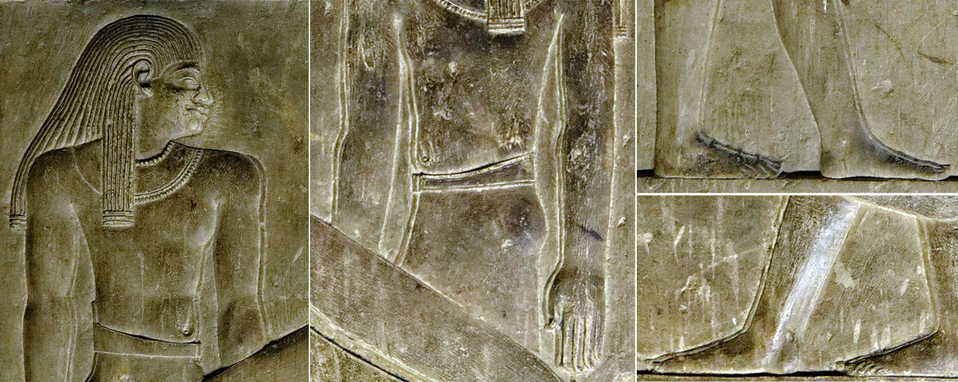
Just like for the giant clams, once you have understood how was operated the Great Pyramid, everything comes into place, with very easy explanations; and the famous Dendera Lights are no exception: they are a perfect drawing of the fog of microdroplets of liquid water; so we shouldn’t be surprised that ancient Egyptians themselves literally described the bulbs as “magical energy in a liquid form” and represented the character holding the fog, being cold himself and represented with a double outline for the goose bumps.
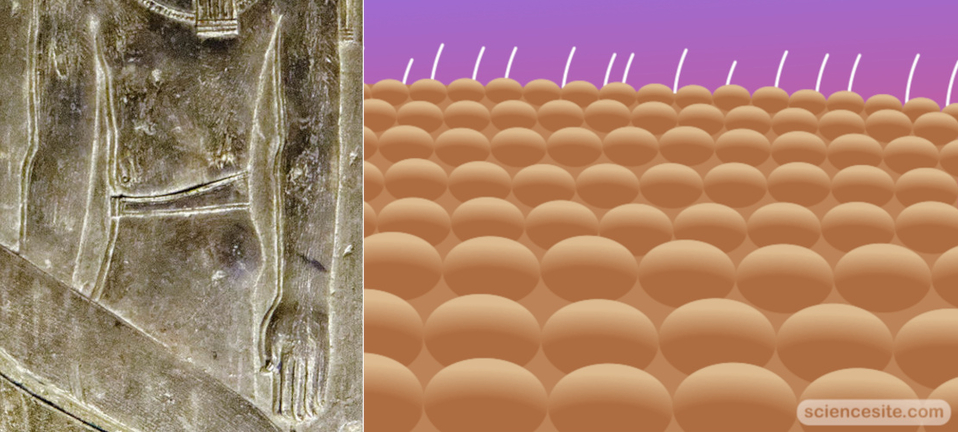
From Science Site: https://sciencesite.com/biology/what-are-goosebumps-and-why-do-we-get-them/
44.30 Cold gave goose bumps, even 4,500 years ago
More on the Dendera Light bulbs, the meaning of the lotus flower, the goose bumps and the fog nozzle of the evaporative cooling passage in Section 2: the-pyramids-of-the-cold-v2/section-2-the-dendera-light.html
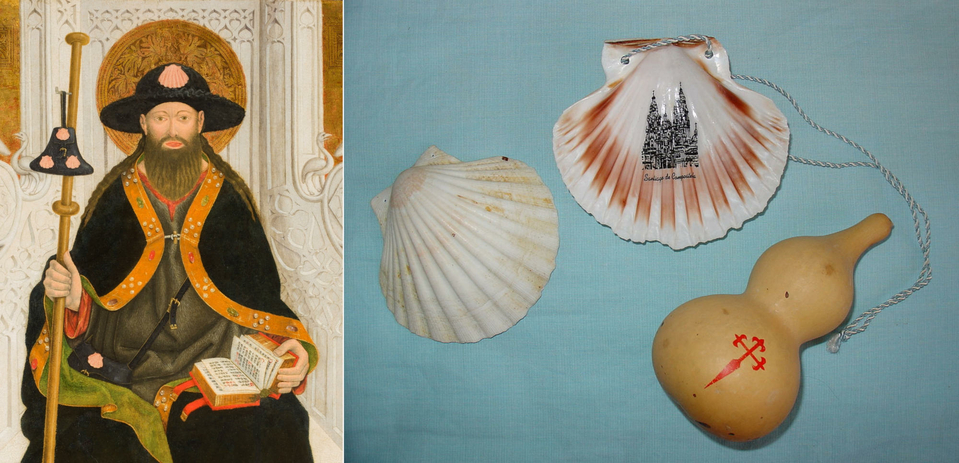
Saint James the Pilgrim, by Baro Bartomeu. ©Museo Nacional del Prado
Traditional St James pilgrim accessories used on the Camino de Santiago (chemin de Compostelle), by Retama: https://en.wikipedia.org/wiki/Camino_de_Santiago#/media/File:Vieira_Camino_de_Santiago.jpg
44.31 The scallop’s shells in Christianity are also about purified water
We’ve just seen that giant clams are the ancient Christian way of celebrating the biosand filter of the Great Pyramid; it is then only logical to ask ourselves if the scallops, another kind of clam that is also filtering salted water its entire life and that is mostly celebrated in the Pilgrim Saint James and in the Camino de Santiago (Saint Jacques et le Chemin de Compostelle in French), is also about the filter, and if so what particular aspect of the filter the scallop is directly referring to.
44.32 The Saint James Pilgrim’s gourd itself is actually the answer to what really is representing the scallop shell and it is indeed all about "the virtue of purifying water"
On the right above image you can see the two most important traditional St James pilgrim accessories for the Camino de Santiago (the Pilgrimage of Compostela in Galician or in English the Way of St. James): of course the scallop shell itself, and right next to it there is the Pilgrim’s gourd.
Academic explanations tell us that the gourd only has a practical interest, but now we know this is wrong: both the scallop shell and the gourd are telling us the exact same story, and that is the production of potable water. In other terms, the Pilgrim’s gourd is the answer to what really is representing the scallop shell.
In short: what is in the Pilgrim’s gourd (that is purified and potable water), comes right from the scallop’s shell.
“The scallop shell is associated with one of the 23 miracles performed by St James. When St James cured a knight who suffered from a throat disease by putting a scallop on the affected area, word spread and people started to put scallops near their beds, hanging them on the outside door, putting it near animals drinking places. […] Some medieval texts give the shell the virtue of chasing rodents from fields or purifying water and wine.” https://followthecamino.com/en/blog/the-scallop-shell-and-other-symbols-of-the-camino/
“There is a wide variety of stories, legends, and myths about the origin of the Camino de Santiago shell. The most popular that you will hear are:
44.33 If you are not ready to really work on the metaphoric representations of the ancient World, there is no point in trying to understand anything about it and you should stick to the academic stories
In the last following excerpt, it is suggested that pilgrims used the shell to “drink water from springs and streams”, but why would they have done that if each and every single Pilgrim had a mandatory gourd? If you have a gourd, that is absolutely perfect to store and use potable water, why the hell would you even try to use a scallop to do the job? Did anyone even try to do it? Because believe me, if you have both hands available you will always end up using these hands rather than a scallop shell!
This academic explanation of the scallop shell that is trying to make it a simple drinking tool is only one out of many other examples of the simplistic and childish vision that historians have of our common ancestors; and of course the shells are no tools, but metaphoric representations.
Both giant clams and scallops are metaphoric representations of the filter… they are no tools.
1 • The association of the scallop shell with the pilgrimage is related to its use by pilgrims to drink water from springs and streams.” https://followthecamino.com/en/blog/the-scallop-shell-and-other-symbols-of-the-camino/
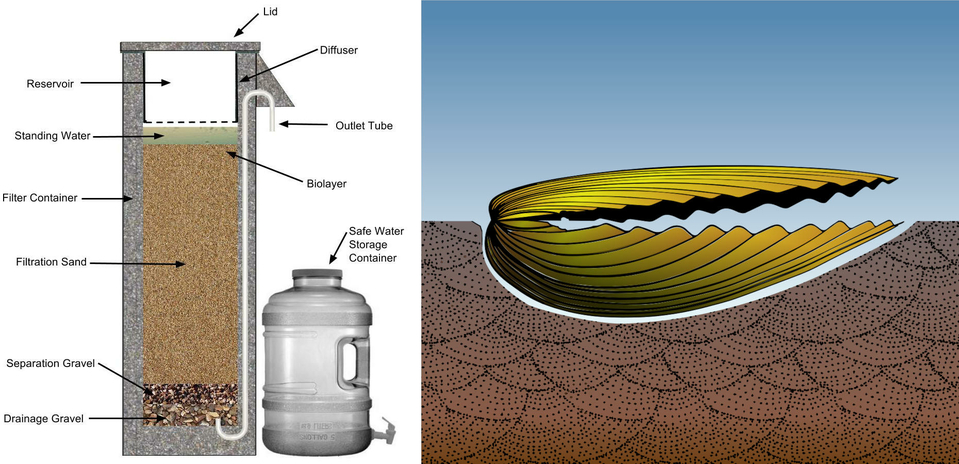
Biosand filter at ohorizons.org/blog/biosand-filters-reliable-affordable-sustainable-clean-water-for-life
Diagram of a scallop with two differently sized valves shown positioned in ocean floor sediment: the right valve (shown at the bottom) much deeper than the left, allowing the scallop to appear less visible to predators; by KDS4444: https://en.wikipedia.org/wiki/Scallop#/media/File:Buried_inequivalved_scallop.svg
44.34 Again, with the scallop’s shell, people should really stop constraining their vision to the empty shells of dead animals and seek the specific characteristic(s) of the glorious live animal: the scallop's flat hinged cover
We’ve just seen that Christian’s holy water fonts are often made with giant clam’s shells because the fonts are all about biosand filters, metaphorically capable of producing potable water for every member of the community. In short, the representations of clams in Christianity, are all about the glorification of the filter; and since I’ve understood that the so-called “Sarcophagus” of the Great Pyramid is actually the remaining “body” of an ancient Egyptian biosand filter, I’ve always wondered if there was a wooden lid just like every single modern biosand filter has.
Remember, the original operating position of the sarcophagus/biosand filter, was in what is today the electrical room, a room that most of the people interested in the Pyramid aren’t even aware of its very existence (and I still didn’t find any pictures of it, anywhere on the internet); so it is quite difficult to decide if there was a lid (probably made in wood, just like today), or if the filter was operated in opened air in this very little chamber (just like regular industrial sand filters of today).
Amazingly, the importance given to sea scallops by Christianity, is probably giving us the answer: there was indeed a lid onto the filter, probably in wood, and it explains why no massive granite lid had ever been discovered anywhere inside the Great Pyramid.
Also, sea scallops do have a “perfect and straight” hinge; so the question is: did the biosand filter of the Pyramid also have one?

Detail of Saint James the Pilgrim. Painting by Baro Bartomeu. ©Museo Nacional del Prado, Madrid, Espagna. High definition original image available on the museum's site: https://www.museodelprado.es/en/the-collection/art-work/saint-james-the-pilgrim/b501632b-e994-4c79-bec4-136ecddf4890
44.35 The joint of the book in Saint James's hands in Bartomeu's painting
If you look attentively to the book in the hands of Saint James, you will see (at least one of) the secret(s) of the painting: the central hinge or spine that is allowing to open and close the book. Just like for, directly (the experimental part like Isis, Ra or Osiris) or indirectly (the theoretical part like Shu, Geb and Nut), all the ancient Egyptian gods and goddesses already deciphered in this Study, Saint James is nothing but the glorification of one very particular aspect of the operating of the Great Pyramid: here Saint James is about the endless opening and closing of the biosand filter’s wooden hinged lid.
Probably the lid was opened every day, at the end of the day, when the team of the Grand Gallery did finished its endless job to haul the impactor. I encourage you to click on the link towards the original image of the painting for a better appreciation of the “hinge” of Saint James’s book.
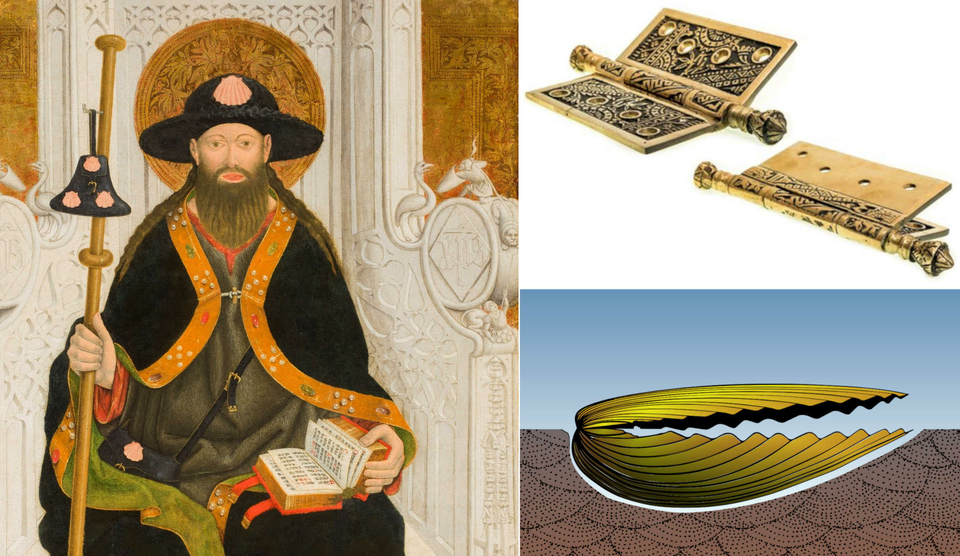
Saint James the Pilgrim, by Baro Bartomeu. “The image of the titular saint seated on a richly decorated Gothic throne was the central effigy of many Spanish late mediaeval altarpieces. Here we see a hieratic Saint James with his pilgrim’s attributes enthroned on a monumental cathedra in grisaille, adorned with lively marginalia.” ©Museo Nacional del Prado: https://www.museodelprado.es/en/the-collection/art-work/saint-james-the-pilgrim/b501632b-e994-4c79-bec4-136ecddf4890
Antique brass hinges from Charleston Hardware; image: https://www.pinterest.fr/pin/37436240644869044/

44.36 The car mechanic opening up the engine hood modern metaphor
We’ve just seen that the real meaning of holy water fonts was hidden in the specific feeding of the giant clams, and that the process of cleaning the filter gained a huge amount of interest in Christianity: the filter had to be metaphorically cleaned as many times as possible, and that every single person dipping the hands in the fonts were participating in that process.
But with the scallop shells, this is the very beginning of that process that is worshiped: the part of the operation of the biosand filter where you decide to stop the filtration and start the cleaning by opening up the lid. It is funny because it reminds me the moment when car mechanics open the engine hood of the car and can finally have a look at the “beast” that is the motor of the car.
Image: https://www.wikihow.com/Open-the-Hood-on-a-Mini-Cooper
44.37 The idea of emerging out of the water
Nowadays, every single biosand filter I’ve seen did have a lid, but this lid never was in direct contact with water, and it is legitimate to ask ourselves if it was also the case in the Great Pyramid. The fact is that the idea itself of the scallop shell being associated with getting in and out of water is perfectly known in a myth that exists in many form and in which scallop shells are literally getting out of water.
When it is said in the following excerpt that “the horse and rider emerged from the water, covered in seashells”, what should be understood is that it only is the top and flat part shell it is all about.
I didn’t see it at once, but the idea itself of the cover (a lid is nothing but a cover), is literally used in the myth: “the horse and rider emerged from the water, covered in seashells”,
“The scallop shell, often found on the shores in Galicia, has long been the symbol of the Camino de Santiago. Over the centuries the scallop shell has taken on a variety of meanings, metaphorical, practical, and mythical, even if its relevance may have actually derived from the desire of pilgrims to take home a souvenir. […] One myth says that after James's death, his body was transported by a ship piloted by an angel, back to the Iberian Peninsula to be buried in what is now Santiago. As the ship approached land, a wedding was taking place on shore. The young groom was on horseback, and, upon seeing the ship's approach, his horse got spooked, and horse and rider plunged into the sea. Through miraculous intervention, the horse and rider emerged from the water alive, covered in seashells.” https://en.wikipedia.org/wiki/Camino_de_Santiago
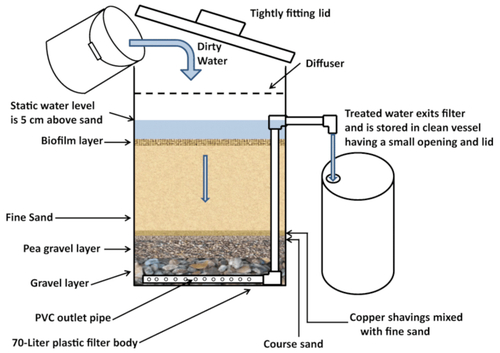
44.38 The opening of the biosand lid model: the scallop shells
“The model scallop shell consists of two similarly shaped valves with a straight hinge line along the top, devoid of teeth, and producing a pair of flat wings or "ears" (sometimes called "auricles", though this is also the term for two chambers in its heart) on either side of its midpoint, a feature which is unique to and apparent in all adult scallops.” https://en.wikipedia.org/wiki/Scallop
“The scallop shell, often found on the shores in Galicia, has long been the symbol of the Camino de Santiago. Over the centuries the scallop shell has taken on a variety of meanings, metaphorical, practical, and mythical, even if its relevance may have actually derived from the desire of pilgrims to take home a souvenir.
One myth says that after James's death, his body was transported by a ship piloted by an angel, back to the Iberian Peninsula to be buried in what is now Santiago. As the ship approached land, a wedding was taking place on shore. The young groom was on horseback, and, upon seeing the ship's approach, his horse got spooked, and horse and rider plunged into the sea. Through miraculous intervention, the horse and rider emerged from the water alive, covered in seashells.” https://en.wikipedia.org/wiki/Camino_de_Santiago
Biosand filter schematic (figure available from: Water Air and Soil Pollution): https://www.researchgate.net/figure/BSF-schematic-filter-specifications-are-similar-to-those-described-by-CAWST_fig1_334280491

Hippopotamus resting onto rocks, at the bottom of a pond, in San Diego Zoo, by cloudzilla: https://fr.m.wikipedia.org/wiki/Fichier:Hippopotamus_in_San_Diego_Zoo.jpg
44.39 The beautiful and mandatory metaphorical encoding process of the ancient technological prowess
I know this is something I’ve already said many times, but if there is just one thing you really want to remember about this study, it is the tremendous importance that acquired animal representations in the ancient World; and if they did, it only is because they were used as simple tools, just like the ancient Egyptian goddess Taweret who took the form of an hippopotamus, only because Taweret only is the personification and the glorification of the block which sealed the inclined well of the operating Great Pyramid: the block was standing at the bottom of the well, just like an hippopotamus would do.
I’ve received many messages of people trying to decipher the Great Pyramid in their own ways, but none that was based or supported by any glorifying metaphor coming from the ancient World, myths or deities. As a result, none of these theories can be right, in any way.

“For anyone holidaying in the US coastal town of Cape Cod, the plates of seafood in many of the restaurants hold a particular allure. But it is not just in feeding the locals and visitors that businesses have been relying on shellfish - they are using them to help clean the water. Oysters effectively act as sieves in water where there is too much nitrogen, as in Cape Cod, where such excess levels might otherwise lead to rampant algae growth. Oyster shells incorporate the nitrogen as they grow, taking it into their shells and out of the water and preventing harmful algea blooms. It is one example of the remarkable phenomenon of shellfish being a natural filter - and one that never switches off. Oysters can filter over 200 litres of water a day. The humble mussel acts as a vacuum cleaner for the sea, taking in microplastics, pesticides and other pollutants. Where man has created problems through pollution, the natural world has fought back”. Shellfish: the kidneys of the sea; May 10, 2021, a document issued by Bank Lombard Odier & Co Ltd or an entity of the Group (hereinafter “Lombard Odier”): https://www.lombardodier.com/contents/corporate-news/responsible-capital/2021/may/shellfish-the-kidneys-of-the-sea.html

44.40 Kidneys, as clams are both filtration units
If water is displayed so well in Christianity, we’ve already seen that except for Hapi and Hapy, it wasn’t the case in the ancient Egyptian religion; but we’ve already seen in Section 27 (The guide to the Afterlife for the smart traveler and the canopic jars), that Egyptians found their own way of celebrating the biosand filter: they literally worshipped kidneys, the filtration organ of the body, and they’ve made sure most of the time that the kidneys were left inside the body of the deceased body. Kidneys, as clams are both filtration units.
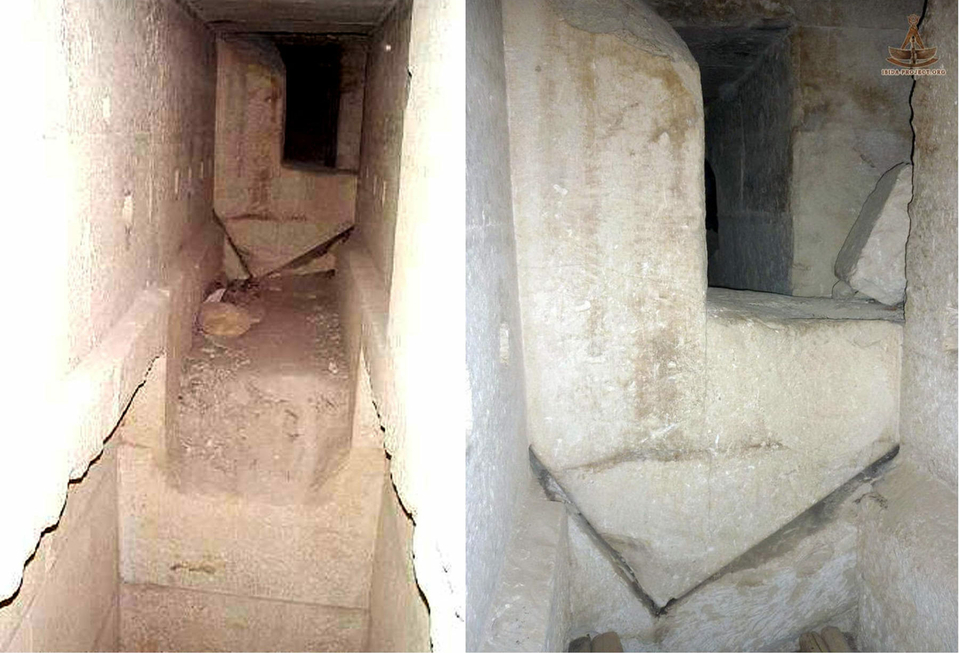
The sand filter of Sneferu's Bent Pyramid that nobody wants to talk about, even though its entire layout is still in place today: the supplying portcullis, the collecting basin and of course the sand itself still inside the almost intact “mold”. On the above photographs, the curious L shape of the portcullis is only due to the first egyptologists to enter the passage and who needed to get pass through the portcullis, so they simply cut it out. Images from guardians.net: https://guardians.net/egypt/cyberjourney/dahshur/bentpyramid/bent_pyramid_interior.htm
More on the sarcophagus in Section 29: the-pyramids-of-the-cold-v2/section-29-the-biosand-filter-sarcophagus.html
The Pyramids of the Cold version 2 (May 2023 - May 2024)
Summary of the study and Table of Contents
Part A: The evaporative cooling process
Section 1 • The horizontal evaporative cooling passage layout
Section 2 • The Dendera Light and the creation of the fog of microdroplets by the fog nozzle
Section 3 • The water cycle glorifying metaphors: Geb, Shu, Nut, Tefnut
Section 4 • The theorization of the evaporative cooling process by Akhenaten and Nefertiti
Section 5 • The theorization of the evaporative cooling process in the Weighing of the Heart
Part B • The inclined well of the Great Pyramid of Giza
Section 6 • The inclined well layout and the girdle stones
Section 7 • The Taweret "Lady of the Well" temporary sealing granite plug of the well
Section 8 • The Bes temporary wedging block immobilizing Taweret
Section 9 • The draining of the well
Section 10 • The Great Serpent Apep and the snake water metaphors
Section 11 • The Was scepter and the control over "snakes"
Section 12 • The beating Heart of the Great Pyramid
Part C • The composite impactor of the Great Pyramid (Horus, Ra, Osiris, Medjed, Sobek...)
Section 13 • The wooden and stone composite design of the impactor: Ra and Osiris
Section 14 • The endlessly immersed Osiris stone and the seed metaphor
Section 15 • The Anubis sledge and the bobsled mask
Section 16 • The sledge runners of the impactor: Thoth
Section 17 • Medjed: the smiter nobody can ever see
Section 18 • The Apis bull and the ramming impactor's metaphors
Section 19 • The crocodile god Sobek impactor (more or less) floating in the waters of the well
Section 20 • The Obelisk and the Benben stone rising from water
Part D • The Grand Gallery's of the Great Pyramid of Giza
Section 21 • The Sacred "sloping paths" of the "oval-shaped cavern of the act of Hauling"
Section 22 • The central wooden caisson of the Gallery: Sekhmet and the Triad of Memphis
Section 23 • The hauling ropes of the Grand Gallery: Isis, Nephthys, Hatmehit, Wadjet and Nekhbet
Section 24 • The hauling Beetle and the Seven Scorpions of Isis
Section 25 • The Great Cow goddess Hathor and the operating cycle of the hauling Beetle
Section 26 • The 10 operating phases of the Grand Gallery
Section 27 • The guide to the Afterlife for the smart traveler and the canopic jars
Section 28 • The scarab amulet glorifications of the hauling Beetle
Part E • The very large and roughly finished sarcophagus of the Great Pyramid
Section 29 • The biosand filter sarcophagus of the Great Pyramid
Section 30 • The Elephantine Triad deification of the biosand filter of the Great Pyramid
Section 31 • The Great Pyramid's operating flat roof and the water supply issue
Part F • Chemical manufacturing and industrial cooling before the Great Pyramid
Section 32 • The Serdab and the "Refreshment of the Gods" Step Pyramid of Djoser
Section 33 • Sneferu's Red Pyramid and the accumulated ammonia
Section 34 • The Disc of Sabu and the Solvay process for pure natron manufacturing
Part G • The tremendous impact of the Great Pyramid on the whole ancient world
Section 35 • The hidden secrets of the Hermetica Emerald Tablet (around 1600 C.E.)
Section 36 • Thor and the magical Hammer in the Great Hall of Bilskirnir
Section 37 • The Churning of the waters of the Ocean of Milk (Hindu mythology)
Section 38 • The Tibetan prayer wheels and the Grand Gallery's operation
Section 39 and Conclusion • The cooling water of spitting Kebechet
Part H • Epilogue
Section 40 • The smiting Ark of the Covenant and the Ten Commandments
Section 41 • The 293 kilograms windlass Staff of Moses and Aaron... and the First Plague of Egypt: water turning into blood
Section 42 • Ezekiel's Four Egyptian pulley "Wheels within the Wheels" and the four angel ropes
Section 43 • David, Saul, two giant Goliaths, five little stones, an aeolian harp... and a weaver's beam
Section 44 • The holy water fonts and the biosand filter
Part I • The magicians of the Great Pyramid of Giza
Section 45 • The Legend of Khufu and the "magician" polymath Imhotep
Section 46 • The two magical eyes of Isis and the brilliant but painful flame of her twin sister's braids
Section 47 • The Aegis Shield of Athena "Subduer of the Winds" and the upper hatch of the central wooden caisson
Section 48 • The Seven Magical Words spoken by 'Divine Sealer' Goddess of Arrows and Bronze Neith
Poster un commentaire

